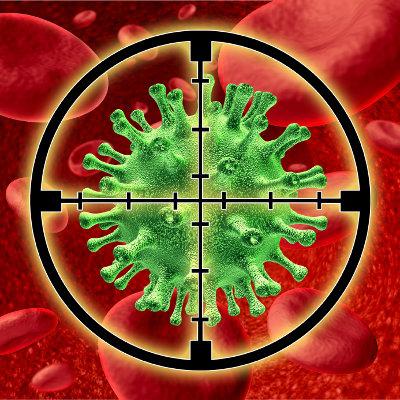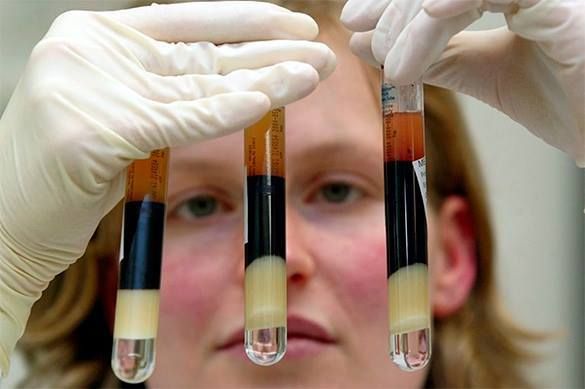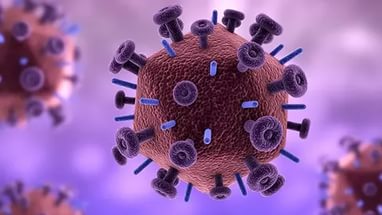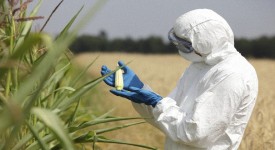Colds and flu are the most common diseases. Adults catch colds on average 2-3 times a year, and children 2-3 times more often. 1 The word “cold” itself is a general name for a disease that can be caused by one of hundreds of similar viruses. The list of pathogenic organisms is so large that doctors make a diagnosis only approximately based on symptoms - if they make it at all. The symptoms of the disease will go away before the doctor can find out which virus caused the disease!
Immunity Challenge
Considering how challenging cold viruses pose to us, there is no cure for them. The human immune system must fight the virus. Cold and flu viruses are constantly changing in appearance, so the body cannot immediately recognize the enemy “in a new guise” and provide adequate protection. If the immune system does not fight back in time, or in cases of encountering a particularly aggressive strain, we get sick.
How does a virus “think”?
To be precise, viruses are not even living organisms. They are more than a thousand times smaller than bacteria and represent only a small chain of DNA or RNA in a protein shell. Once in the body, they attach to our cells and force them to reproduce the virus. Sooner or later, such a cell dies, and the viruses it produces target new healthy cells.
How does the body fight cold and flu viruses?
When a certain number of cells are damaged, the body's immune system turns on, sending special cells and proteins to the affected areas to eliminate the virus, and this causes inflammation. This is why the body temperature rises with the flu. The unpleasant symptoms that we experience during illness are a consequence of the body's fight against the virus, and are not caused by the microbes themselves.
Why are these symptoms needed?
One of the first noticeable manifestations of the disease is yellow or green nasal discharge. The body produces them in order to bind malicious virus. These secretions are produced by one of the enzymes produced by red blood cells and serve as a clear sign of infection. 3 But the color of the discharge cannot determine whether the nature of the disease is bacterial or viral.
Muscle pain, especially pronounced with the flu, is also a consequence of the body's immune response: proteins are required to fight the virus, so less protein reaches the muscles, which makes you feel tired and sore. But by increasing the amount of protein in your diet, you can alleviate these unpleasant sensations. 3 If you need help selecting a drug to eliminate a specific symptom, use the search: Vicks /drugs/Vicks-solution-finding-tool/ - we will help you choose the right Vicks drugs.
Be optimistic
Don't forget to smile even when you're not feeling well. Studies have shown that a positive attitude and communication strengthen the immune system and reduce the likelihood of illness. This great way strengthen your immune system so you can rely on it during the season of illness.
Runny nose, cough, tears for no reason, complaints about a headache and throat, such a familiar picture. “Everything is clear,” the parents conclude. “The baby has caught a cold.” And they tensely remember when and where he got his feet wet, when he became hypothermic. All this can indeed weaken the baby’s body and reduce resistance to infections, but remember: the direct culprit of the disease is a virus. And the doctor in these cases diagnoses ARVI (acute respiratory viral disease).
Source: depositphotos.com
Features of viral diseases
It is not always possible to determine from the clinical picture which group of viruses is causing the disease, because most of them are characterized by common symptoms - the same runny nose, cough...
- Adenoviral infections last quite a long time, up to two weeks, and the child has a severe runny nose, conjunctivitis, and sometimes a cough.
- Parainfluenza most often affects the larynx, the voice becomes hoarse, sometimes disappearing completely, and the cough is barking and rough. It is parainfluenza that causes such a serious complication as false croup.
- usually occurs with a very high fever, headache, and aches throughout the body. At the beginning of the disease, the child may not have a cough or runny nose.
- Enteroviral fevers occur more often in the spring; They are also characterized by high fever, muscle pain, and abdominal pain.
Unlike, for example, measles or chickenpox, immunity after ARVI is unstable. And if the child is weakened by another past illness or stressful situation, then ordinary hypothermia can become a provocateur of ARVI. In addition, during the heating season, many viruses “fly” in the dry air in the kindergarten. This fall, according to forecasts from the World Health Organization, for example, increased activity of three strains of influenza is expected:
- virus variants A/California/7/2009 (H1N1) – “swine” flu;
- virus variants B/Brisbane/60/2008;
- influenza A/Hong Kong/4801/2014 (H3N2) virus variants.
So parents should be on their guard. With ARVI and influenza, local immunity first decreases and the so-called nasopharyngeal ring suffers: tonsils, lymphoid tissue of the nasopharynx, epithelium of the upper respiratory tract. A runny nose, cough, sore throat begins, and the temperature often rises. ARVI is dangerous primarily due to its complications. In order to avoid them, the child must be seriously and intensively treated.
Parental misconceptions and their consequences
There is a common saying: “If a runny nose is treated, it goes away in a week, but if left untreated, it goes away in seven days.” But alas, this is not entirely true, especially in relation to children.
Another common belief is that at the first sign of a cold, and even more so when the temperature rises, you should immediately start giving antibiotics. But this is a fundamentally wrong decision, because antibacterial drugs only act on bacteria, and they are powerless against viruses! But if antiviral drugs are ignored and not taken in time, then the following outcome may well occur - a bacterial infection will appear on the 4-5th day, and then antibiotics will be required.
But this moment can be prevented if you start taking antiviral drugs. In the early stages of influenza and acute respiratory viral infections, a child can be given, for example, children's forms of the drug "Tsitovir-3" as a therapeutic and antiviral agent, instructions for which are available on the drug's website. given by the Research Institute of Influenza of the Russian Academy of Medical Sciences, the Research Institute of Children's Infections of the Ministry of Health of the Russian Federation, the Research Institute of Experimental Medicine of the Russian Academy of Medical Sciences and many others. Especially for children, “Tsitovir-3” is produced in the form of a powder without taste or with three fruit flavors to choose from: orange, cranberry and strawberry. Please note that Cytovir-3 powder is safe for allergy sufferers and can be given to children from 1 year of age.
How does the body fight viruses?
 The main components of "Tsitovir-3" are ascorbic acid, bendazole and alpha-glutamyl-tryptophan. And they all work together as a complex antiviral drug: it stimulates the antioxidant system and immunity, enhances the body’s production of natural interferon, and activates natural antiviral defense mechanisms.
The main components of "Tsitovir-3" are ascorbic acid, bendazole and alpha-glutamyl-tryptophan. And they all work together as a complex antiviral drug: it stimulates the antioxidant system and immunity, enhances the body’s production of natural interferon, and activates natural antiviral defense mechanisms.
Scientists have calculated that the preventive use of children's forms of "Tsitovir-3" increases the body's resistance to infection by ARVI pathogens up to 5 times, negating protracted forms of ARVI. And taking it in the first hours after infection reduces the period of illness and the likelihood of complications in the form of pneumonia and acute bronchitis.
Thus, according to researchers, it is an effective antiviral drug that is perfect for treating influenza A and B, ARVI in children when the first symptoms appear, and for prevention to strengthen the immune system.
Ant tree bark has long been used in Brazilian folk medicine to treat colds, flu, herpes and stomatitis virus
Colds, flu and other infections caused by viruses negatively affect human health. Although prevention is considered the most effective way treatment, there are a number of folk remedies that can stop the virus in its tracks. Below are the most effective folk remedies that have a proven ability to block the reproduction of viruses.
Why do viruses multiply in the body?
When winter seems to drag on forever, there is often a decline in immune system activity. Therefore, a person becomes prone to colds, flu, herpes and other viral infections. Viruses are tiny particles of nucleic acids that invade living cells and divert the cells' resources for replication (reproduction). Some folk remedies are known to support immunity and can help strengthen the immune system's resistance to viral infections. Are there folk remedies that can destroy viruses and shorten the duration of the disease they cause? Fortunately, there are many available folk remedies that have antiviral properties. In most cases, such folk treatment is represented by herbs, as well as two metals - silver and zinc.
Colloidal Silver to Treat Hundreds of Diseases
Colloidal silver has been used in folk medicine for medicinal purposes since ancient times. It is known that in the period from 1900 to 1940. There were various forms of silver that were used to treat hundreds of diseases. Recently, interest in the use of this folk remedy has grown. Colloidal silver is a suspension of tiny particles that do not dissolve even when the concentration changes. Colloidal silver is used in modern supplements and is a suspension of pure silver metal in water. This folk remedy is believed to work by blocking enzymes that allow viruses, bacteria and fungi to use oxygen (in effect, silver “suffocates” these microorganisms). Preliminary studies show that folk remedies based on colloidal silver can be used not only to treat “simple”, most common viruses, but even to block the replication of the hepatitis C virus and the HIV virus in AIDS patients.
Zinc – treatment for herpes and cold viruses
Several double-blind, placebo-controlled studies have shown that zinc is effective means to treat colds. Zinc acetate and zinc gluconate reduced the duration and severity of cold symptoms. Topical application of zinc is also used to treat cold sores caused by the herpes simplex virus. One study showed that the use of zinc monoglycerolate resulted in complete cure of herpetic lesions in 70% of individuals, while zinc oxide had a therapeutic effect in only 9% of individuals. Thus, it is very important which form of zinc is used. Positively charged Zn2+ ions are effective against herpes and cold viruses. This remedy prevents viruses from multiplying because it blocks the process by which strands of nucleic acids are linked. The amount of Zn2+ ions available to the body is greatest in supplements containing zinc acetate (almost 100%) and zinc gluconate (about 30%), but is almost zero with other forms of zinc (such as citrate, orotate and picolinate). The presence of Zn2+ ions in the additive is indicated by the appearance of dry mouth (bonds are formed with salivary proteins).
Black elderberry is an effective folk remedy for the flu virus, herpes and HIV
Black elderberry has long been used in food, and is also one of the oldest folk remedies. These berries are especially effective in treating the flu virus. In a double-blind clinical study, more than 90% of 15 patients who took elderberry extract (60 ml per day for adults and 30 ml for children) showed a significant reduction in flu symptoms after two days and full recovery after three days. Persons who took this folk remedy also contained more high levels antibodies to the influenza virus, indicating an increased immune response. In an independent study conducted by Norwegian scientists, elderberry extract was shown to significantly reduce the duration of flu symptoms by approximately four days. This folk remedy is believed to be effective in treating the influenza virus because it binds to tiny proteins on the surface of the virus, allowing it to enter living cells. Flavonoids, including quercetin, may also be involved in the medicinal effects of black elderberry. These flavonoids include anthocyanins, which are powerful antioxidants and protect cells from damage. The possibility of using this folk remedy to treat other viral infections, including HIV and herpes, has been studied. In laboratory conditions, it was found that this folk remedy significantly reduces the virulence of HIV strains and completely inhibits the replication of four strains of the herpes simplex virus, including two strains resistant to the drug acyclovir.
Olive leaves are a folk remedy for inhibiting a large number of viruses.
Olive trees grow around the Mediterranean Sea and were probably first planted in Crete around 3500 BC. Olive oil is a staple part of the Mediterranean diet and is very beneficial for cardiovascular health. The leaves of olive trees contain a bitter substance called oleuropein. In laboratory studies, one of the components, elenoic acid, has been shown to be a powerful inhibitor large number viruses: influenza, herpes, polio and Coxsackie. Calcium elenolate also acts on retroviruses in leukemia by blocking reverse transcriptase enzymes, which ensure viral replication by changing the DNA and RNA of healthy cells. Studies in infected hamsters have shown that calcium elenolate reduces parainfluenza myxovirus 3 and prevents its spread to the lungs. A controlled clinical trial in Budapest involving over 500 patients found that olive leaf extract was extremely effective in treating a wide range of conditions. Complete and rapid recovery after taking olive leaf extract was observed in 115 of 119 patients with respiratory tract infections and in 120 of 172 patients with herpes.
Green tea - a traditional Chinese medicine
Green tea is a traditional Chinese medicine that has been used for over 4,000 years. Its health benefits have been proven in numerous studies. Green tea contains a group of flavonoids - catechins, which can inhibit viral infections. Catechins bind to the hemagglutinin of the influenza virus and thus prevent the virus from entering the host cell. Research in China has shown that the action of green tea extract and catechins is also based on blocking viral enzymes: reverse transcriptase and DNA polymerase, which are necessary for viruses to replicate. A number of studies have shown that this folk remedy effectively suppresses HIV, herpes and hepatitis viruses.
Licorice root against mutated influenza, HIV and hepatitis viruses
It happens that mutations of the influenza virus occur, resulting in epidemics that claim thousands of lives. Scientists from the Institute of Medical Virology in Frankfurt studied the effectiveness of four drugs (including ribavirin, which is recommended for treatment) and the substance glycyrrhizin found in licorice root against coronavirus samples from patients with SARS. The results, published in The Lancet, showed that glycyrrhizin outperformed all four drugs in suppressing the virus. Unlike drugs, this drug was not toxic to cells infected with the virus. Glycyrrhizin leads to a decrease in viral replication and inhibits the uptake of viruses onto the external cell, as well as their ability to penetrate into the cell. This folk remedy has also been shown in laboratory studies to inhibit the replication of HIV. Clinical studies have shown that glycyrrhizin injections may have beneficial effects on AIDS. There is also preliminary evidence that oral administration of this folk remedy may be safe and effective for the long-term treatment of HIV infection. A preliminary study in people with acute and chronic viral hepatitis found that taking 2.5 g of licorice root three times daily (provided with 750 mg of glycyrrhizin) was superior to the effects of the antiviral drug inosine. Licorice extract may be an effective treatment for many other viral diseases.
Pau D'Arco - divine tree in Brazilian folk medicine
Pau D'Arco - lapacho or ant tree bark - is a tree with a huge pink dome of flowers native to the Amazon rainforest. This “divine tree” has long been used in Brazilian folk medicine to treat a wide range of ailments, including colds, flu, herpes and stomatitis virus. The inner cortex contains a large number of chemicals called quinoids. One of the most studied of these compounds is lapachol. This substance is active against various viruses, including herpes simplex types 1 and 2, influenza, polio virus and vesicular stomatitis virus. The mechanism of action of this folk remedy is based on the inhibition of DNA and RNA polymerase and retrovirus reverse transcriptase (the same mechanism in olive leaves and green tea).
St. John's wort is a folk remedy for the treatment of influenza viruses, herpes and HIV.
The herb St. John's wort is a well-known folk remedy for depression, and is also used for wound healing, and also relieves pain from neuralgia, fibrosis and sciatica. Laboratory studies have shown that this folk remedy also has antiviral activity against influenza viruses, herpes simplex and HIV. Hypericin and pseudohypericin are chemicals found in St. John's wort that are active against enveloped viruses. These are viruses that tear off a piece of cell membrane when they leave an infected cell and wrap themselves in it to trick the body's immune system. Herpes, HIV and hepatitis C viruses are types of enveloped viruses. Hypericin and pseudohypericin attack these fragments of the cell membrane (but do not attack the membranes of living cells).
Garlic - a folk remedy since the times of the pharaohs
Garlic has been cultivated for over 5,000 years. This folk remedy was appreciated by the Egyptian pharaohs. Many cultures have used garlic as a folk remedy for colds and flu. In laboratory studies, garlic has been shown to have antiviral, antibacterial and antifungal properties. The antiviral and other medicinal properties of garlic are provided by numerous compounds included in its composition, which have a joint effect. The most significant of these is allicin, which produces the pungent odor of garlic. It is produced from another compound, alliin (when fresh garlic is cut or chewed), and can also be obtained from powdered garlic supplements. Aged garlic does not contain allicin, but may have some antiviral activity due to the presence of allylcysteine. Several laboratory studies have confirmed that garlic is an excellent means of destroying cold viruses, as well as herpes simplex viruses types 1 and 2.
Echinacea for treating viruses that affect the respiratory tract
Echinacea purpurea supports the immune system and may also have a direct antiviral effect. Several clinical studies have shown that preparations of Echinacea roots and flowering parts are effective in reducing the severity and duration of symptoms in patients with colds, upper respiratory tract infections, and viral bronchitis symptoms.
Folk remedies that have antiviral properties can and should be used in the complex treatment of diseases such as influenza, herpes and even hepatitis and HIV. In some cases (colds and flu), even the use of one folk remedy (for example, black elderberry) can provide protection adequate to taking several pharmaceutical drugs. For some folk remedies, the ability to kill viruses in vitro has been proven, for some - in clinical studies. It is ideal to take a holistic approach to treating viral diseases. This involves the use of several antiviral folk remedies along with immune-boosting nutrients (vitamins A, C and E, zinc, selenium, coenzyme Q10 and probiotics).
Currently, there is no way to completely kill the HIV virus in the human body. The disease leads to irreversible damage to many organs, which is accompanied by a decrease in the quality of life and a significant reduction in life.
Due to the fact that HIV can only be killed outside the human body, research has established the conditions under which it dies. This knowledge is used in methods for preventing the spread of infection and disinfecting medical and other instruments that may come into contact with the patient’s blood.
At what temperature does HIV die?

To find out at what temperature AIDS dies, it is necessary to isolate the pathogen and evaluate its viability in various environments. To conduct such experiments, chicken embryos are most often used, into which infected material is introduced. Once the presence of the virus in the embryo is confirmed, its examination begins.
Based on the experiments conducted, we can conclude that the retrovirus dies at a temperature of 50-70 °C, subject to exposure for 30-40 minutes. To determine under what conditions and at what temperature HIV dies instantly, many experiments were carried out using infected blood from patients. Based on research data, it can be stated that at 100°C or more the virus loses activity instantly. Therefore, to disinfect the patient’s belongings, it is enough to boil them for several minutes.

Not all items can be disinfected in this way, so it was found out how quickly HIV would die at a lower temperature. It has been established that temperatures of 10-15°C lead to a slowdown in the life activity of the pathogen and its slow death, while levels of 50-60°C contribute to the almost instantaneous death of the immunodeficiency virus. We can conclude that even in this temperature range, HIV dies quite quickly.
At what temperature does the AIDS virus die outside the human body?

Outside the human body, the pathogen is viable for less than a minute. Therefore, it is believed that it is almost impossible to become infected with HIV in a bloodless manner. Since the theory of the structure of a pathogenic cell is calculated only mathematically, it is impossible to find out what changes occur in a microorganism during its interaction with the environment. The only reliable result can be obtained by conducting an experiment with chicken embryos in vitro. It shows how long it takes for HIV to die outside the body, and whether it is possible to cultivate it in this way. Based on this study, it can be stated that at temperatures below 35.0°C outside the human body, the retrovirus dies almost instantly. Cultivation of the microorganism in chicken embryos is possible, but does not last long.
Does the temperature of the disinfectant solution affect the virus? It dies at temperature conditions of 50°C, so if you treat surfaces with liquids of this temperature regime and higher, you can kill the AIDS virus with a probability of more than 90%. However, knowledge about the temperature at which the HIV virus dies is often not applied; the pathogen is sensitive to any, even cold, disinfectants.

At what temperature does HIV die when exposed to UV rays? During irradiation chicken embryos ultraviolet rays, scientists wanted to know how long it takes for HIV to die under such influences. It quickly became clear that ultraviolet rays do not have a detrimental effect on the virus. In connection with this fact, it makes no sense to talk about the harmful effects of sunlight on the pathogen.
In what other conditions does HIV die? The HIV virus dies upon contact with oxygen molecules within a few minutes. This is evidenced by the impossibility of transmitting infection by airborne droplets and through household items. Moreover, the higher the humidity in the environment, the greater the likelihood of its preservation as a biological species.
In what environment does the AIDS virus die? The AIDS virus dies due to strong oxidation of the environment in which it is located. In this case, humidity will not affect its activity.
At what temperature does the HIV virus die in an alkaline environment?

An alkaline environment promotes the preservation of the pathogen. Therefore, the human body is an excellent reservoir for its habitat. Under such conditions, a retrovirus can multiply and produce billions of virions per day with the help of body cells, while the latter are more sensitive to environmental changes than the pathogen itself.
Factual evidence that the microorganism is perfectly preserved at a temperature of +37-37.5 °C in alkaline conditions is the increased risk of contracting immunodeficiency in women who often suffer from sexually transmitted diseases. These pathologies are accompanied by a change in the vaginal environment to an alkaline one, which increases the proliferation of microorganisms that cause gynecological diseases. The temperature of human internal organs is 37-37.5 °C and the virus quickly multiplies in tissues, affecting more and more structures.
At what temperature does the HIV (AIDS) virus die in the human body? In the body, AIDS dies only under the influence of antiviral drugs, so taking them is mandatory. Exposure to temperature can lead to fatal consequences for humans. When unfavorable conditions arise for the life and reproduction of HIV, it quickly penetrates into the cell and can remain there for several years. When appropriate conditions are restored, it resumes its immunotropic and neurotropic actions.
At what temperature does the AIDS virus die on metal tools?

Such devices are best suited for cleaning and disinfection. They can be treated at low and high temperatures with various compounds and disinfectants.
Medical institutions have their own method of processing instruments, but each of them is configured specifically to destroy viruses and bacteria that may be on the surface of objects. For example, in nail salons they use the treatment of instruments with universal disinfectants and the calcination method immediately before use. It must be remembered that after such actions the instrument is considered sterile for 5-6 hours. In this regard, when visiting beauty salons, you need to ensure that objects that the client comes into contact with are processed immediately before use. If you need to quickly disinfect devices, annealing is best. In this case, the temperature should reach 100-120 °C. HIV dies at temperatures that reach these numbers almost instantly.
Using this knowledge, you can not only avoid accidental infection with immunodeficiency, but also prevent the introduction of other pathogens into the body. HIV is considered one of the vulnerable infections, so it is not difficult to kill in the external environment.
If there is a possible contact with the pathogen, you do not need to hope for a good immune response from your body and that the virus may have died at one of the stages of infection. You should immediately seek emergency medical attention within 24-48 hours. Statistics show that emergency prevention prevents the development of AIDS by 99.9%, while retroviral treatment only weakens the effect of the pathogen in the body and helps slow down its reproduction. Many medicines have been created in the world that can slow down the spread of infection, but do not kill the HIV virus.
Several viruses and infections can be present in the human body throughout his life. And if some of them periodically remind of their existence, for example, the herpes virus, then others hide for a long time. But even the absence of acute symptoms does not prevent viruses from weakening the body.
Before answering the question of how to get rid of viruses in the body, you need to understand where they live. Many doctors claim that viral bacteria prefer to be on the mucous membranes and in the intestines. Their presence disrupts the functioning of many organs and systems, and without adequate treatment for viruses, diseases become chronic.
Purgation
Bran. Coarse grains are excellent for cleansing the intestines. For months, consume bran 3 times a day, 10 grams before each meal. You need to wash them down big amount water.
Herbal collection. Brew a mixture of herbs (rhubarb, dandelion, mint and fennel), taken in equal proportions. Leave for 1 hour, then strain and consume 100 ml. The course lasts 2 weeks.
Rice. To prepare the cleanser, rinse the rice and leave it to soak in clean water for 5 days. The water must be changed periodically. Then cook the rice and eat it for breakfast without adding salt or oil. Soaked rice is an excellent absorbent; it draws out harmful substances from the body.
It is advisable to cleanse the intestines 2 times a year, even in normal health.
Boosting immunity
Viruses become active when a person’s immune defenses are reduced for certain reasons. Without strengthening the immune system, those viruses that cannot be destroyed will continue to cause trouble for the body. First of all, change your attitude towards life, get rid of bad habits, establish a healthy diet and move more.
Nature provides humans with many healthy foods that will help improve immunity. Adding garlic, lemon, honey and bee bread to your daily diet will diversify your usual dishes and strengthen your immune defense. The solution to the problem of how to get rid of viruses in the body must be deliberate, but quick.






